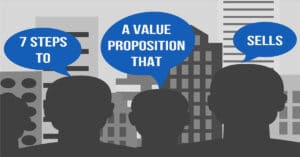In a buyer-focused value proposition, your Offer Statement is the logical extension of the Buyer Objective Statement (our previous article). Based on research and experience over the years, I have come to understand that it is imperative to address both personal benefits as well as organizational benefits to potential buyers. This is why we begin with the Buyer Objective Statement. The key now is to extend that as you create your Company Offer.
Your Buyer Objective Statement has articulated your understanding of the problem the buyer is trying to solve. You want the Offer Statement to communicate HOW your offer is going to address those specific business needs of your buyer. You want this statement to precisely express the primary reasons that your offer can help them. But be careful here. You don’t want to include everything there is to tell about your offering. Why? Because your buyers don’t care about everything! They only care about what is relevant to their own needs.
Furthermore, this must be compelling because you are trying to set yourself apart and gain their attention. You want buyers to say “Yes, that’s me!” when they hear this statement. Often, this section will get morphed into the core part of an elevator speech. Think about the one or two things about your solution to their business needs that you want them to have top-of-mind. This isn’t about product features. This is about the value of the solution you are offering to them. Beware of stuffing features in here to prove value. Don’t dilute your message with non-essential information. The real value here is in your ability to MEET THEIR NEEDS. Features are merely a means to that end. What value will they derive from adopting your solution? That is the question!
Beware of “Marketing-speak”
Another essential aspect of this section is making sure your Offer Statement is understandable to your target market. Understandability is a huge point here. Just because your Marketing and Sales people understand it, there is no guarantee that your new prospects or existing customers do. Acronyms, or very technical language, or internal company jargon typically end up in this section. It complicates the statement unnecessarily. It can also make your buyer feel underinformed. If your audience doesn’t know what it means, many of them won’t bother to find out – they will just move on.
Similarly, be sure to weed out all traces of “marketing-speak” in your offer. By that I mean generic, fluffy marketing language that doesn’t mean anything specific. If it doesn’t directly apply to the business needs in the Buyer Objective, then it doesn’t belong in the Offer Statement. It should be tight, clear, and in the language of the buyer. Value Propositions do not come with “translators,” so don’t put a prospect in the position of needing one.
Finally, but most importantly, you need to be able to quantify all of the claims you make in this section. If you say that you increase productivity, then you need to be able to say by how much with a specific number or a range. If you can’t articulate it, it will not be credible to the buyer. Anyone can say they increase productivity or reduce costs or help with generating additional revenue. Without Quantification, it isn’t unique or differentiating – it is vague, “me too” language that ends up just being an exercise in “marketing-speak.” Make your quantification real by being specific and backing it up. Otherwise, it simply isn’t believable, and therefore has no place in your offer.
With all those additional suggestions and guidelines, let’s work on the Offer Statement. You’ll do multiple drafts of this section – and to keep on track, refer to your latest “Buyer Objective” statement to ensure that you are connecting your offer there. A good rule of thumb in crafting this section is to ask the following:
Can everything in our Offer Statement be linked back
to the buyer needs we have identified?
Any parts that do not connect to the buyer’s needs gets cut out. Don’t stuff your Offer Statement with things that are not relevant to the buyer’s needs.
Instructions for the Offer Statement
Let’s take a crack at crafting an Offer Statement. Here are a few simple basic guidelines to follow:
- You are creating a 1-3 sentence statement that describes your offer – no more than that.
- Your offer must specifically address your buyer objective – it must tie back to the business needs stated there.
- Beware of jargon or acronyms that your buyer may not be familiar with. On the other side of that coin, avoid using generic terms that don’t provide specific enough information.
- Keep it simple and direct – resist the urge to put in everything you know about your offer. Stick to the main aspects. You will have the opportunity to get down into the details in your marketing and sales materials later.
To illustrate, here are a couple of real examples of Offer Statements, to give you an idea of the direction to go in. Notice that they stay pretty high level and, by design, do not include too much detail. They do not include all the features of the offer. The value proposition is meant to attract buyers. By matching your Offer Statement to the buyer objective, you are building the means for that attraction. Remember, this is just the beginning of conversation – not the entire conversation.
Example 1:
In response to these client and market needs we have focused our healthcare and professional services resources, along with our technology, information system and work process re-engineering expertise to create and deliver the following business benefits and results:
- Improve cost efficiencies for claims and patient services by 25%
- Increase cost savings by 15% for our customers
- Increase patient record accuracy to meet government mandates by 10%
Example 2:
[Product Name] is an application deployment and management system that dramatically reduces the time and effort required to launch and manage applications on business-critical servers. Proven to scale across thousands of servers across geographic regions, the system delivers the ability to deploy, troubleshoot, repair, upgrade, operating and manage servers from a single system.
Making sure your Offer Statement is firmly based in the Buyer’s Objectives is possibly the most important aspect of the creation of a customer-focused value proposition. Your company will distinguish itself from the competition simply by taking these steps to ensure that the solution you are selling matches up with the problem that needs solving, and then making that crystal clear to the buyer.




